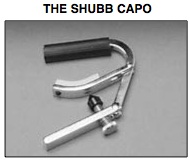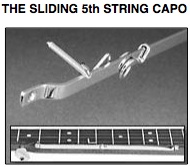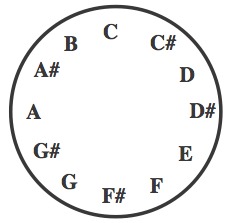|
HOME | LIST OF JAM SESSION CHORD PROGRESSIONS | FREE GUITAR CHORD CHARTS FREE MANDOLIN CHORD CHARTS | FREE BANJO CHORD CHARTS |
||||||||||||||||||||||||||||||||||||||||||||
FREE BANJO LESSONS Bradley Laird's Free Bluegrass Banjo Lesson site is here! FREE CLAWHAMMER BANJO LESSONS Bradley Laird's Free Clawhammer Lesson site is located here! FREE MANDOLIN LESSONS Bradley Laird's Free Mandolin Lesson site is located here! FREE GUITAR LESSONS Bradley Laird's Free Bluegrass Guitar Lesson site is here!
©2015 Bradley Laird |
FREE
CHORD PROGRESSIONS - by Bradley Laird
What is a Capo? A "capo" is a device which clamps the strings down at a particular fret to raise the pitch of the instrument. You can think of it as an artificial finger which lays flat across the fingerboard pressing the strings against a fret. Capos are commonly used on the guitar and banjo, but are rarely used on the mandolin. The bass and the fiddle, having no frets on their fingerboards, cannot use a capo. Here is an example of a capo:
Capos are made in different widths to fit banjos or guitars. Most banjos have a flat fingerboard so a banjo capo is a straight bar. Guitars usually have a slightly curved (radiused) fingerboard so guitar capos have a slightly curving pressure bar. Some sort of screw clamp or lever is used to apply downward pressure of the bar against the strings. Capos have padded surfaces where they contact the strings and the back of the neck, usually made of soft rubber material. If you are a banjo player you also must raise the pitch of the 5th string to match what you did with the other 4 strings. A number of devices have been devised to "capo" the 5th string. Here is a typical example of a sliding capo which attaches to the side of the banjo neck to easily facilitate raising the pitch of that string.
If you only need to go up one or two frets, and you don't have a 5th string capo, it is possible to tune the string up to the higher note. You risk breaking your 5th string if you do this. Some banjo players resort to using small hooks (model railroad spikes) inserted into the fingerboard to hold the string down at preselected frets. There is also a wonderful, yet easy to lose, banjo 5th string capo called the "Reagan" which is great if you don't want to, or don't know how to install one of the sliding, permanent 5th string capos. The "Reagan" is just a little block of brass with a thumbscrew in it for clamping anywhere on the 5th string. They work great! How to Use a Capo To fully understand how to use a capo let's take a look at this diagram of all of the music notes. This is called the "chromatic scale":
The letters shown on the chart can represent single notes, scales, keys or individual chord names since they all operate in the same way. We will confine our discussion here to chords and keys. If you start on any chord on the circle, let's say a C chord, and move clockwise you will be going up in pitch--to a higher sounding chord. Each fret on your instrument corresponds to one position on the circle of chromatic scale notes. For example: If you start on a C chord and count up clockwise two positions you will land on a D chord. This means that D is TWO FRETS higher than C. If you place a capo just behind your 2nd fret and form a C chord shape you will get a D chord sound! Here is another example: Let's say you are playing the song Cripple Creek and you want to play the chords written in the key of G since you only know the G, C and D chords. But, your mandolin player learned the song in the key of A and only knows the melody in A and the chords in the key of A! What do you do so you can play together? Simple. Look at the circle and find the key you want to play the song in. That is G for you in this example. Then find the key that the other person wants you to play in. That is A. Now, starting on a G, count in a clockwise direction the number of positions required to step up to the A. The answer is 2! This means the key of A is 2 FRETS HIGHER than the key of G. So, the guitar and banjo players slap a capo on their second frets and play the song as if it is in G but the sound comes out in the key of A. It is probably obvious to you that once the capo is in place you simply play the instrument like it is slightly shorter and treat the capo as if it were the nut. That is the basic instructions for using the Chromatic Circle to determine how many frets apart any two keys are. Here is a little table showing what the resulting sound is, if you play "G positions" and use a capo to raise the sound. Study this chart and compare it to the notes on the circle above and if it all makes sense you are off to the races.
Look at that table and you can see that you can play in a lot of keys and only "think in a couple of keys." Here is another little bit of music theory to keep in mind: On the circle chart I wrote all those "in between" notes as "sharp" using the "#" symbol. A sharp means the note or chord is raised one fret. All of the notes which are called sharp can also be referred to by an alternate name if they are named for the note above. If they are named for the note above they are called "flat" and are indicated by the "b" symbol. For example: C# (C sharp) can also be called Db (D flat). For all practical purposes they are the same note. Two different names, same sound. G# = Ab, Eb = D#. If you want to explore all of this in a lot more detail check out my video lessons or ebooks here: Banjo eBooks or Mandolin eBooks By the way, capos are rarely used above the 5th fret. Most of the time they are only used up to about the 5th fret. You are free to put your capo where you like, but the tone of the instrument gets a little strange if you capo up at really high frets. Here is a little more information about capos. The rubber that presses the strings down is designed to act like the flesh of your finger. After a long time that rubber will get harder and harder and become "unfingerlike". As that happens, over time, you will have to apply more pressure with the capo to get clean sounding notes AND, very importantly, the strings will be pulled more and more sharp, in terms of tuning, because they are being bent into more of a curve by the capo. To counter the fact that all capos (it's worse when the rubber is old and hard) tend to make the strings go sharp when the capo is applied, here are a few tips: First, don't crank it down any harder than is needed to produce buzz-free, rattle-free sounding notes. The harder you crank it down, the sharper the capo will push your tuning. Second, if you put the capo right behind the fret (like 1/8" back) you can use less pressure to get a clean note than if you place it way back from the fret (like 1/2" back). Try an experiment and put your capo almost all the way back to the 1st fret. (Assuming you were going to capo at the 2nd fret.) Leave as much space as you can between the capo and the desired fret. Play something! You will hear a buzzing mess. Placing a capo too far back causes few tuning problems but allows for tons of buzzing! Incidentally, everything I just said in this and the previous paragraph is true about your fingertips too! The capo is an artificial finger so all of this is true when you fret notes with your digits. Finally, it is hard to tune with a capo locked in place. Yes, you can and sometimes must do it, but be aware that the string will not glide under that tight capo very well. Tune up with open strings and try to put the capo on in such a way that it doesn't screw up your tuning. Download the PDF File: All 100 of the chord progressions from this site are available as a PDF file for printing on 8.5" x 11" pages. The download file includes 90 additional jam session favorites not shown on the website. Get information by clicking here.
Back to Index of Chord Progressions
Follow Me
| |||||||||||||||||||||||||||||||||||||||||||




